Comprehensive Analysis of the Business Environment & Market Structures
VerifiedAdded on 2023/06/09
|9
|2091
|366
Report
AI Summary
This report provides a detailed analysis of the business environment, exploring the distinctions between local, national, and global businesses, along with their significance in the economy. It elucidates the roles of the public, private, and third sectors, providing examples like CafePod, Sainsbury's, Financial Times, HSBC, NHS, and Oxfam to illustrate these concepts. Furthermore, the report examines different types of e-commerce marketplaces, including B2B, B2C, C2C, and C2B, explaining their implications in modern commerce. The varied forms of market structures, such as perfect competition, monopolistic competition, oligopoly, and monopoly, are also discussed, highlighting their impact on the business landscape. The report concludes by emphasizing the importance of understanding these market dynamics for strategic planning and effective business operations. Desklib provides access to this assignment and other solved papers for students.

BUSINESS
ENVIRONMENT
ENVIRONMENT
Paraphrase This Document
Need a fresh take? Get an instant paraphrase of this document with our AI Paraphraser
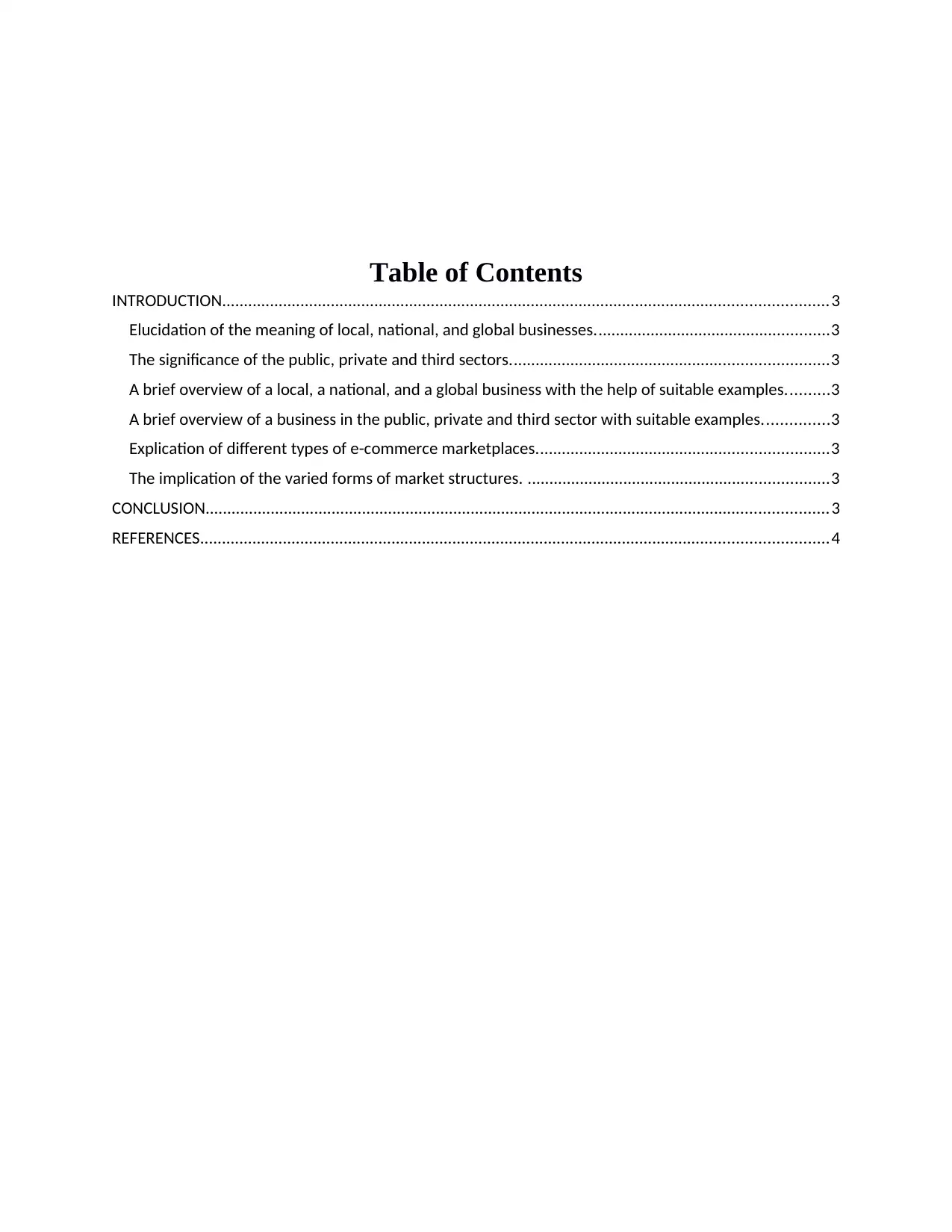
Table of Contents
INTRODUCTION...........................................................................................................................................3
Elucidation of the meaning of local, national, and global businesses......................................................3
The significance of the public, private and third sectors.........................................................................3
A brief overview of a local, a national, and a global business with the help of suitable examples..........3
A brief overview of a business in the public, private and third sector with suitable examples...............3
Explication of different types of e-commerce marketplaces...................................................................3
The implication of the varied forms of market structures. .....................................................................3
CONCLUSION...............................................................................................................................................3
REFERENCES................................................................................................................................................4
INTRODUCTION...........................................................................................................................................3
Elucidation of the meaning of local, national, and global businesses......................................................3
The significance of the public, private and third sectors.........................................................................3
A brief overview of a local, a national, and a global business with the help of suitable examples..........3
A brief overview of a business in the public, private and third sector with suitable examples...............3
Explication of different types of e-commerce marketplaces...................................................................3
The implication of the varied forms of market structures. .....................................................................3
CONCLUSION...............................................................................................................................................3
REFERENCES................................................................................................................................................4
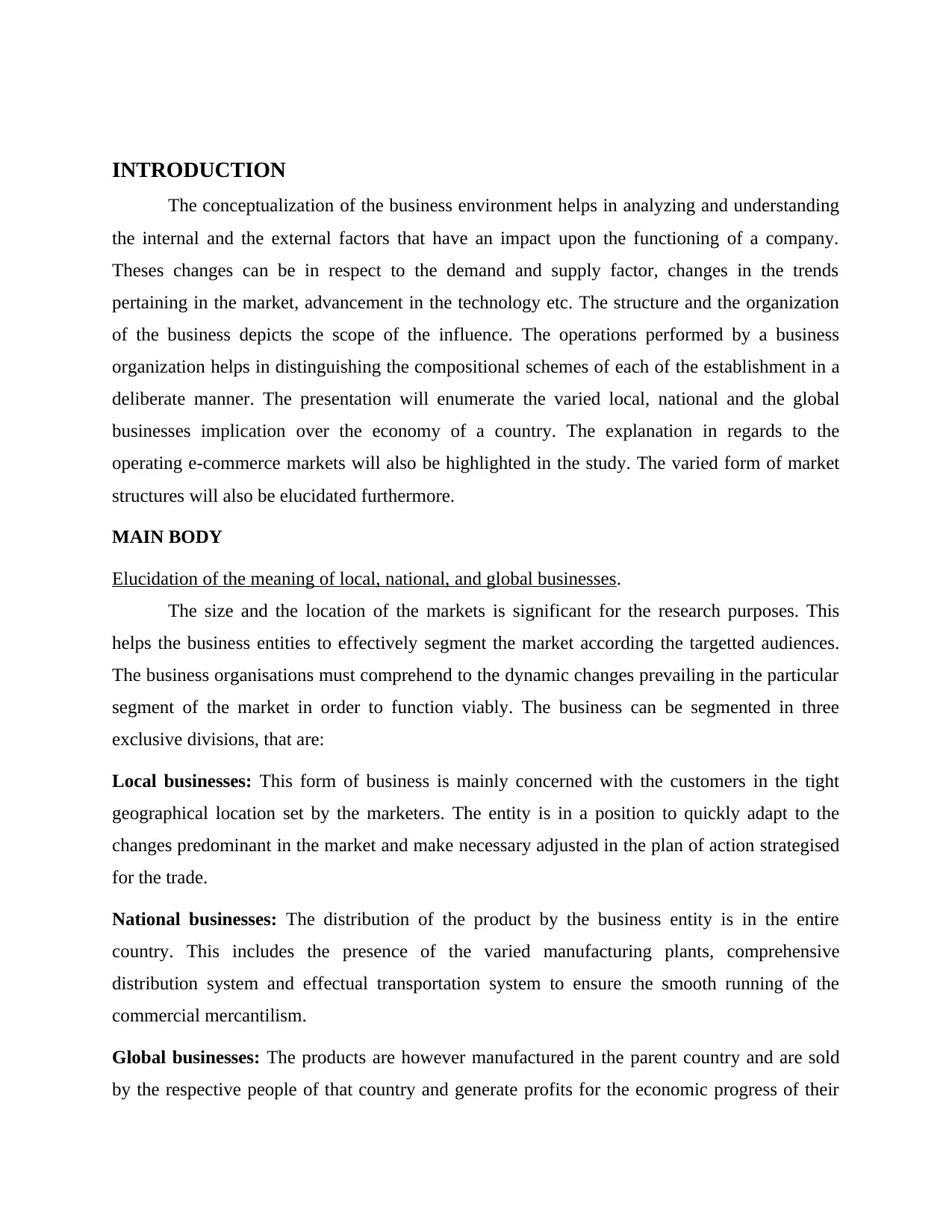
INTRODUCTION
The conceptualization of the business environment helps in analyzing and understanding
the internal and the external factors that have an impact upon the functioning of a company.
Theses changes can be in respect to the demand and supply factor, changes in the trends
pertaining in the market, advancement in the technology etc. The structure and the organization
of the business depicts the scope of the influence. The operations performed by a business
organization helps in distinguishing the compositional schemes of each of the establishment in a
deliberate manner. The presentation will enumerate the varied local, national and the global
businesses implication over the economy of a country. The explanation in regards to the
operating e-commerce markets will also be highlighted in the study. The varied form of market
structures will also be elucidated furthermore.
MAIN BODY
Elucidation of the meaning of local, national, and global businesses.
The size and the location of the markets is significant for the research purposes. This
helps the business entities to effectively segment the market according the targetted audiences.
The business organisations must comprehend to the dynamic changes prevailing in the particular
segment of the market in order to function viably. The business can be segmented in three
exclusive divisions, that are:
Local businesses: This form of business is mainly concerned with the customers in the tight
geographical location set by the marketers. The entity is in a position to quickly adapt to the
changes predominant in the market and make necessary adjusted in the plan of action strategised
for the trade.
National businesses: The distribution of the product by the business entity is in the entire
country. This includes the presence of the varied manufacturing plants, comprehensive
distribution system and effectual transportation system to ensure the smooth running of the
commercial mercantilism.
Global businesses: The products are however manufactured in the parent country and are sold
by the respective people of that country and generate profits for the economic progress of their
The conceptualization of the business environment helps in analyzing and understanding
the internal and the external factors that have an impact upon the functioning of a company.
Theses changes can be in respect to the demand and supply factor, changes in the trends
pertaining in the market, advancement in the technology etc. The structure and the organization
of the business depicts the scope of the influence. The operations performed by a business
organization helps in distinguishing the compositional schemes of each of the establishment in a
deliberate manner. The presentation will enumerate the varied local, national and the global
businesses implication over the economy of a country. The explanation in regards to the
operating e-commerce markets will also be highlighted in the study. The varied form of market
structures will also be elucidated furthermore.
MAIN BODY
Elucidation of the meaning of local, national, and global businesses.
The size and the location of the markets is significant for the research purposes. This
helps the business entities to effectively segment the market according the targetted audiences.
The business organisations must comprehend to the dynamic changes prevailing in the particular
segment of the market in order to function viably. The business can be segmented in three
exclusive divisions, that are:
Local businesses: This form of business is mainly concerned with the customers in the tight
geographical location set by the marketers. The entity is in a position to quickly adapt to the
changes predominant in the market and make necessary adjusted in the plan of action strategised
for the trade.
National businesses: The distribution of the product by the business entity is in the entire
country. This includes the presence of the varied manufacturing plants, comprehensive
distribution system and effectual transportation system to ensure the smooth running of the
commercial mercantilism.
Global businesses: The products are however manufactured in the parent country and are sold
by the respective people of that country and generate profits for the economic progress of their
⊘ This is a preview!⊘
Do you want full access?
Subscribe today to unlock all pages.

Trusted by 1+ million students worldwide
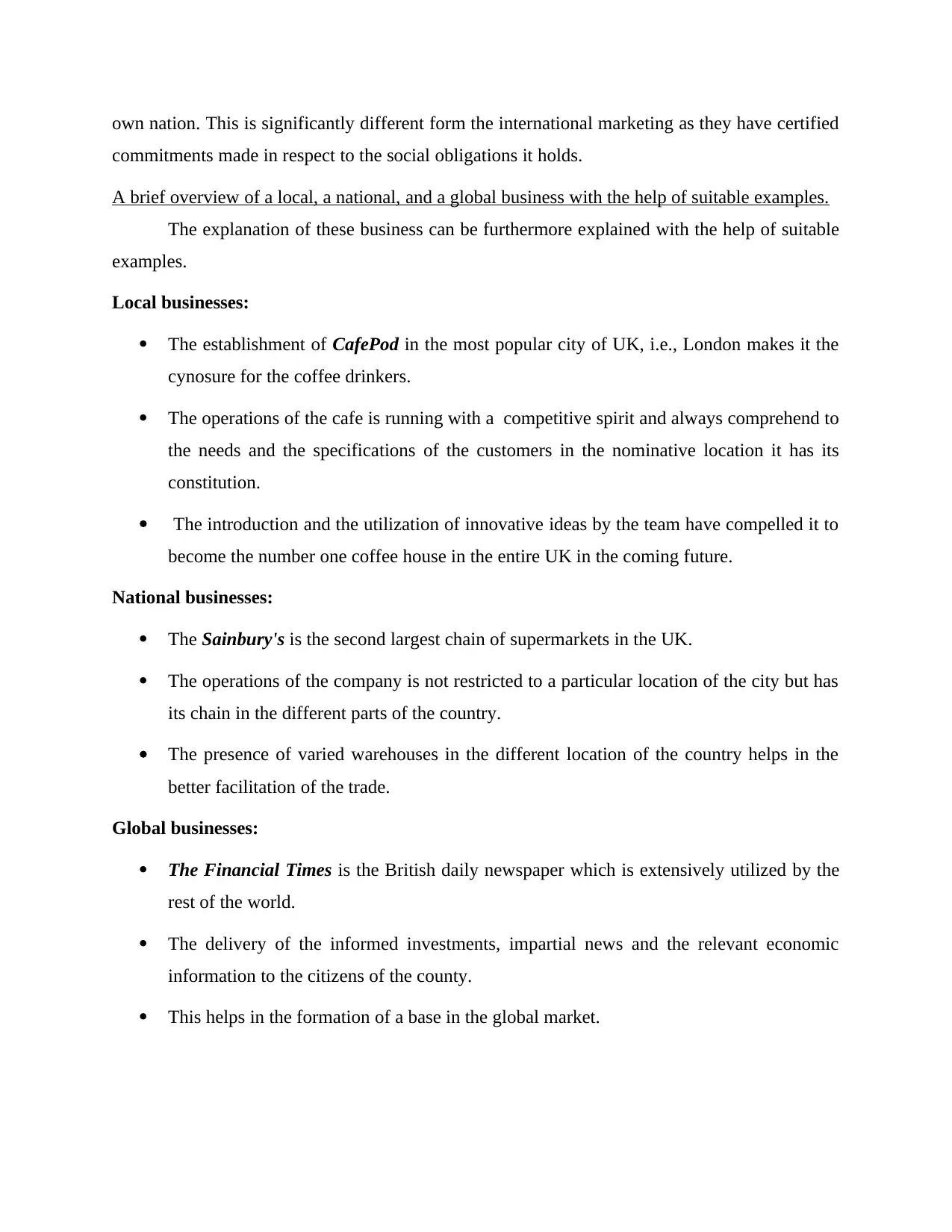
own nation. This is significantly different form the international marketing as they have certified
commitments made in respect to the social obligations it holds.
A brief overview of a local, a national, and a global business with the help of suitable examples.
The explanation of these business can be furthermore explained with the help of suitable
examples.
Local businesses:
The establishment of CafePod in the most popular city of UK, i.e., London makes it the
cynosure for the coffee drinkers.
The operations of the cafe is running with a competitive spirit and always comprehend to
the needs and the specifications of the customers in the nominative location it has its
constitution.
The introduction and the utilization of innovative ideas by the team have compelled it to
become the number one coffee house in the entire UK in the coming future.
National businesses:
The Sainbury's is the second largest chain of supermarkets in the UK.
The operations of the company is not restricted to a particular location of the city but has
its chain in the different parts of the country.
The presence of varied warehouses in the different location of the country helps in the
better facilitation of the trade.
Global businesses:
The Financial Times is the British daily newspaper which is extensively utilized by the
rest of the world.
The delivery of the informed investments, impartial news and the relevant economic
information to the citizens of the county.
This helps in the formation of a base in the global market.
commitments made in respect to the social obligations it holds.
A brief overview of a local, a national, and a global business with the help of suitable examples.
The explanation of these business can be furthermore explained with the help of suitable
examples.
Local businesses:
The establishment of CafePod in the most popular city of UK, i.e., London makes it the
cynosure for the coffee drinkers.
The operations of the cafe is running with a competitive spirit and always comprehend to
the needs and the specifications of the customers in the nominative location it has its
constitution.
The introduction and the utilization of innovative ideas by the team have compelled it to
become the number one coffee house in the entire UK in the coming future.
National businesses:
The Sainbury's is the second largest chain of supermarkets in the UK.
The operations of the company is not restricted to a particular location of the city but has
its chain in the different parts of the country.
The presence of varied warehouses in the different location of the country helps in the
better facilitation of the trade.
Global businesses:
The Financial Times is the British daily newspaper which is extensively utilized by the
rest of the world.
The delivery of the informed investments, impartial news and the relevant economic
information to the citizens of the county.
This helps in the formation of a base in the global market.
Paraphrase This Document
Need a fresh take? Get an instant paraphrase of this document with our AI Paraphraser
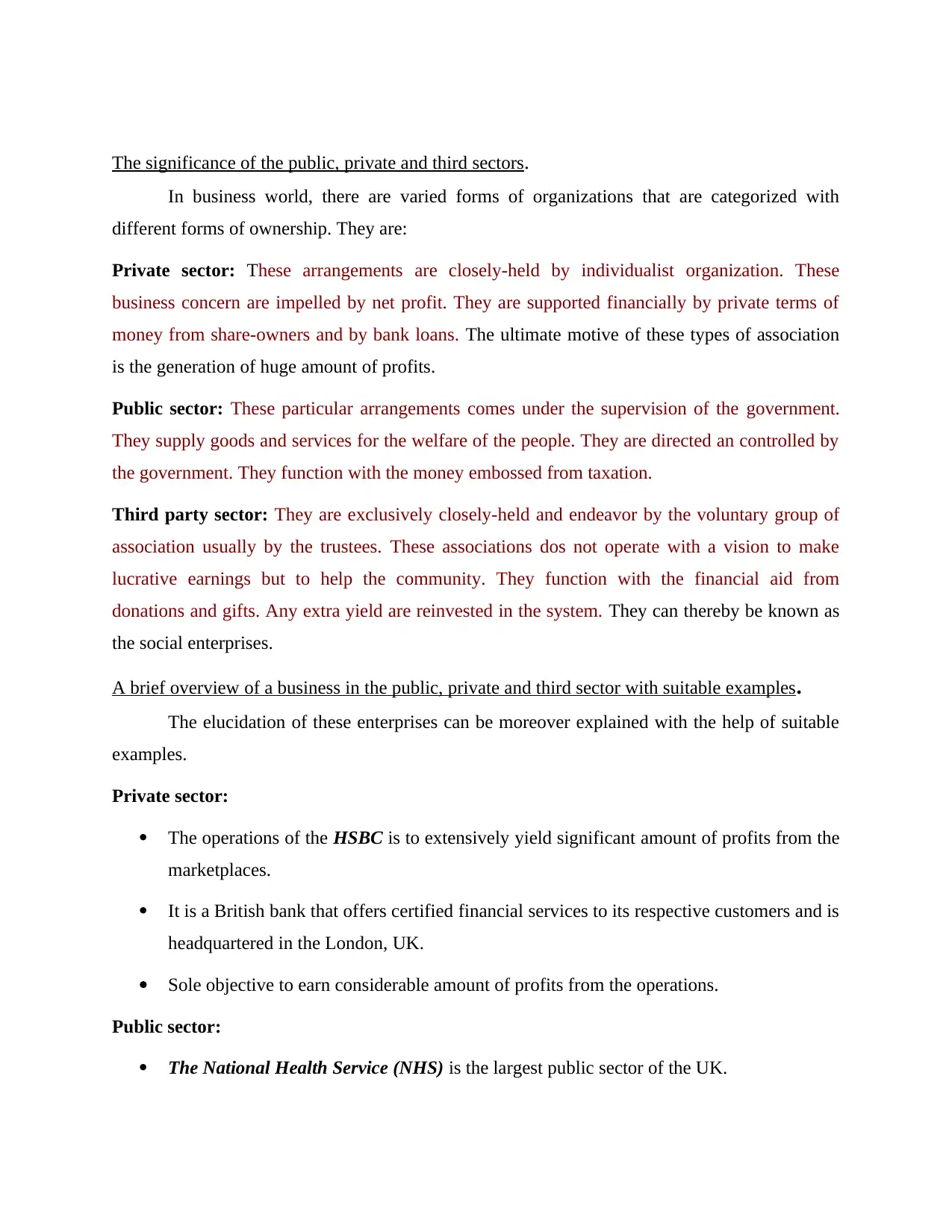
The significance of the public, private and third sectors.
In business world, there are varied forms of organizations that are categorized with
different forms of ownership. They are:
Private sector: These arrangements are closely-held by individualist organization. These
business concern are impelled by net profit. They are supported financially by private terms of
money from share-owners and by bank loans. The ultimate motive of these types of association
is the generation of huge amount of profits.
Public sector: These particular arrangements comes under the supervision of the government.
They supply goods and services for the welfare of the people. They are directed an controlled by
the government. They function with the money embossed from taxation.
Third party sector: They are exclusively closely-held and endeavor by the voluntary group of
association usually by the trustees. These associations dos not operate with a vision to make
lucrative earnings but to help the community. They function with the financial aid from
donations and gifts. Any extra yield are reinvested in the system. They can thereby be known as
the social enterprises.
A brief overview of a business in the public, private and third sector with suitable examples.
The elucidation of these enterprises can be moreover explained with the help of suitable
examples.
Private sector:
The operations of the HSBC is to extensively yield significant amount of profits from the
marketplaces.
It is a British bank that offers certified financial services to its respective customers and is
headquartered in the London, UK.
Sole objective to earn considerable amount of profits from the operations.
Public sector:
The National Health Service (NHS) is the largest public sector of the UK.
In business world, there are varied forms of organizations that are categorized with
different forms of ownership. They are:
Private sector: These arrangements are closely-held by individualist organization. These
business concern are impelled by net profit. They are supported financially by private terms of
money from share-owners and by bank loans. The ultimate motive of these types of association
is the generation of huge amount of profits.
Public sector: These particular arrangements comes under the supervision of the government.
They supply goods and services for the welfare of the people. They are directed an controlled by
the government. They function with the money embossed from taxation.
Third party sector: They are exclusively closely-held and endeavor by the voluntary group of
association usually by the trustees. These associations dos not operate with a vision to make
lucrative earnings but to help the community. They function with the financial aid from
donations and gifts. Any extra yield are reinvested in the system. They can thereby be known as
the social enterprises.
A brief overview of a business in the public, private and third sector with suitable examples.
The elucidation of these enterprises can be moreover explained with the help of suitable
examples.
Private sector:
The operations of the HSBC is to extensively yield significant amount of profits from the
marketplaces.
It is a British bank that offers certified financial services to its respective customers and is
headquartered in the London, UK.
Sole objective to earn considerable amount of profits from the operations.
Public sector:
The National Health Service (NHS) is the largest public sector of the UK.
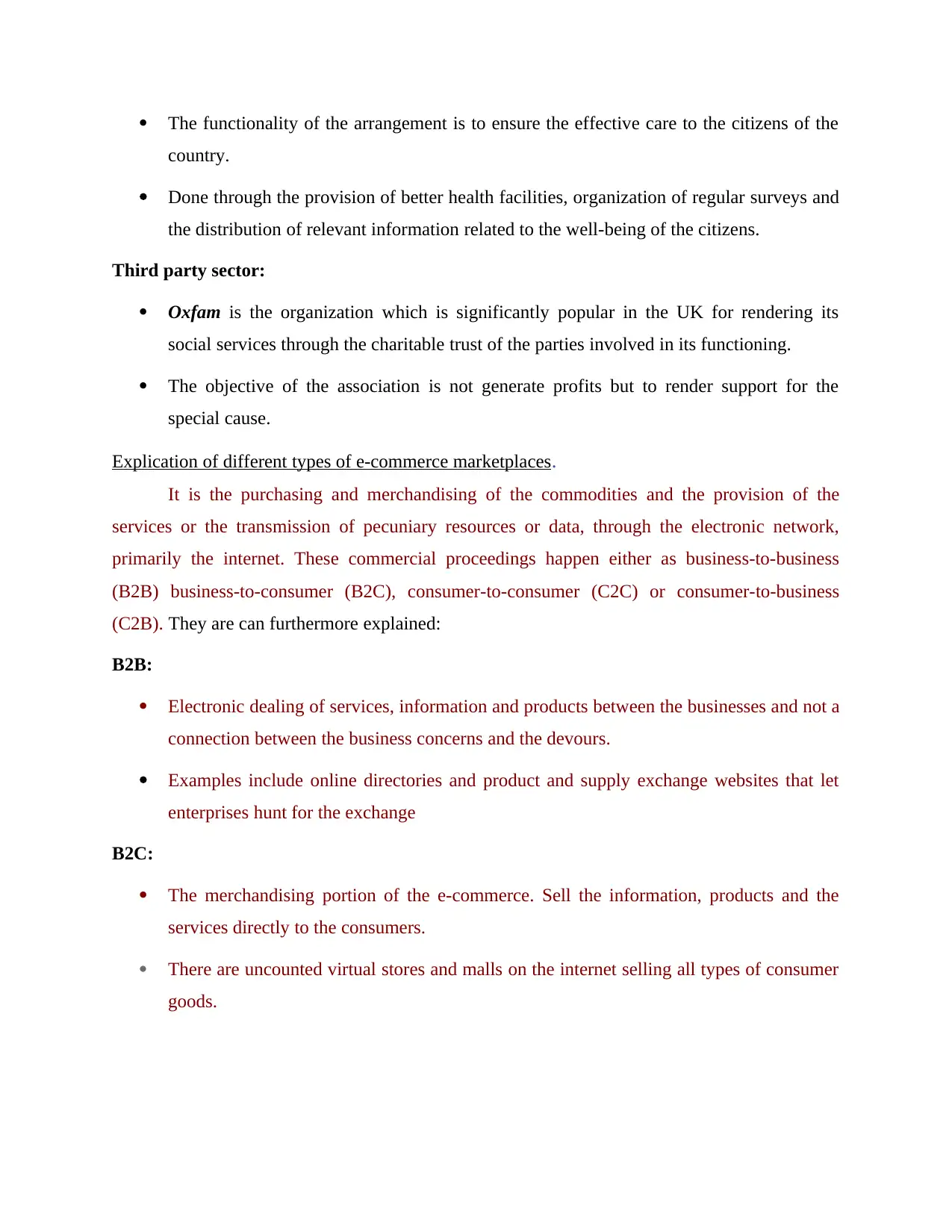
The functionality of the arrangement is to ensure the effective care to the citizens of the
country.
Done through the provision of better health facilities, organization of regular surveys and
the distribution of relevant information related to the well-being of the citizens.
Third party sector:
Oxfam is the organization which is significantly popular in the UK for rendering its
social services through the charitable trust of the parties involved in its functioning.
The objective of the association is not generate profits but to render support for the
special cause.
Explication of different types of e-commerce marketplaces.
It is the purchasing and merchandising of the commodities and the provision of the
services or the transmission of pecuniary resources or data, through the electronic network,
primarily the internet. These commercial proceedings happen either as business-to-business
(B2B) business-to-consumer (B2C), consumer-to-consumer (C2C) or consumer-to-business
(C2B). They are can furthermore explained:
B2B:
Electronic dealing of services, information and products between the businesses and not a
connection between the business concerns and the devours.
Examples include online directories and product and supply exchange websites that let
enterprises hunt for the exchange
B2C:
The merchandising portion of the e-commerce. Sell the information, products and the
services directly to the consumers.
There are uncounted virtual stores and malls on the internet selling all types of consumer
goods.
country.
Done through the provision of better health facilities, organization of regular surveys and
the distribution of relevant information related to the well-being of the citizens.
Third party sector:
Oxfam is the organization which is significantly popular in the UK for rendering its
social services through the charitable trust of the parties involved in its functioning.
The objective of the association is not generate profits but to render support for the
special cause.
Explication of different types of e-commerce marketplaces.
It is the purchasing and merchandising of the commodities and the provision of the
services or the transmission of pecuniary resources or data, through the electronic network,
primarily the internet. These commercial proceedings happen either as business-to-business
(B2B) business-to-consumer (B2C), consumer-to-consumer (C2C) or consumer-to-business
(C2B). They are can furthermore explained:
B2B:
Electronic dealing of services, information and products between the businesses and not a
connection between the business concerns and the devours.
Examples include online directories and product and supply exchange websites that let
enterprises hunt for the exchange
B2C:
The merchandising portion of the e-commerce. Sell the information, products and the
services directly to the consumers.
There are uncounted virtual stores and malls on the internet selling all types of consumer
goods.
⊘ This is a preview!⊘
Do you want full access?
Subscribe today to unlock all pages.

Trusted by 1+ million students worldwide
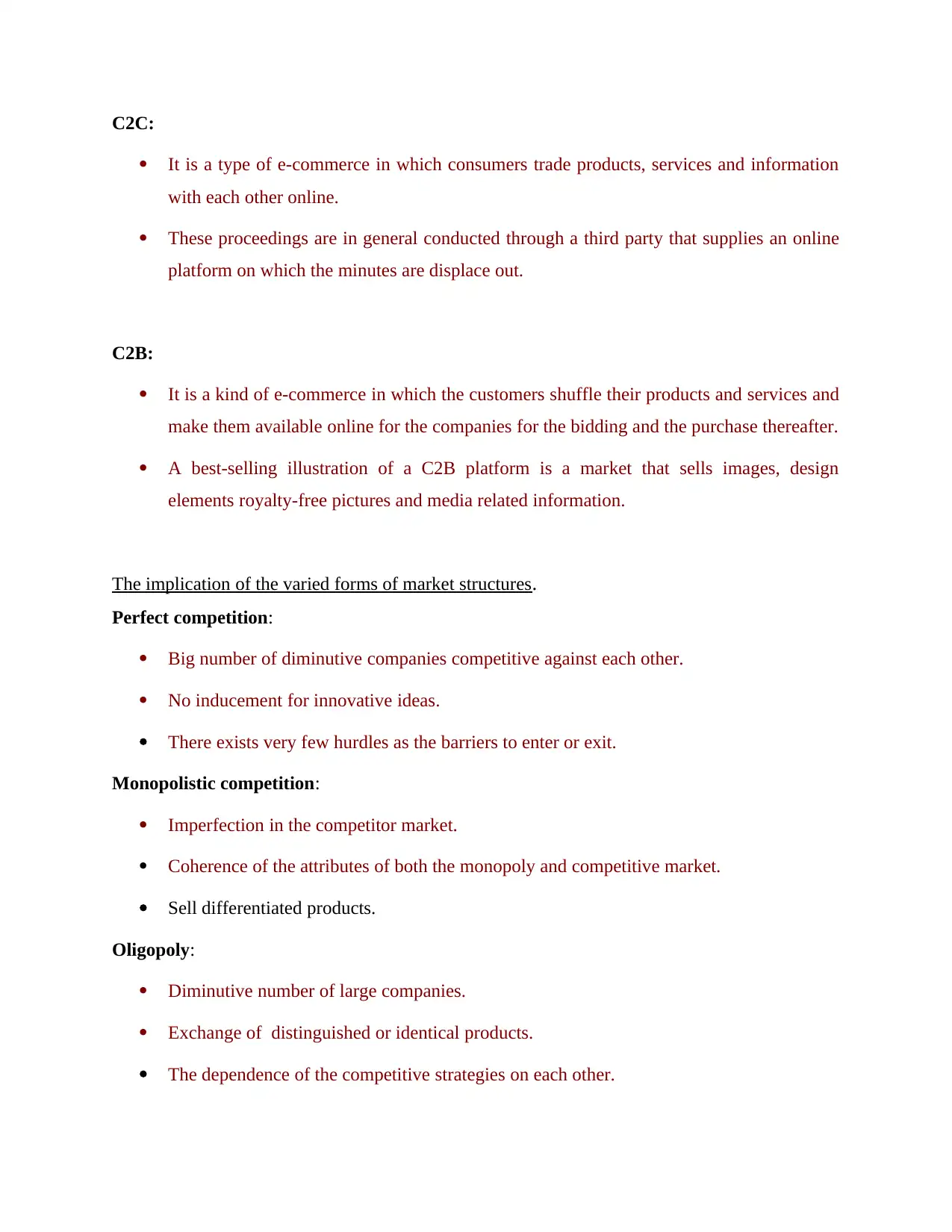
C2C:
It is a type of e-commerce in which consumers trade products, services and information
with each other online.
These proceedings are in general conducted through a third party that supplies an online
platform on which the minutes are displace out.
C2B:
It is a kind of e-commerce in which the customers shuffle their products and services and
make them available online for the companies for the bidding and the purchase thereafter.
A best-selling illustration of a C2B platform is a market that sells images, design
elements royalty-free pictures and media related information.
The implication of the varied forms of market structures.
Perfect competition:
Big number of diminutive companies competitive against each other.
No inducement for innovative ideas.
There exists very few hurdles as the barriers to enter or exit.
Monopolistic competition:
Imperfection in the competitor market.
Coherence of the attributes of both the monopoly and competitive market.
Sell differentiated products.
Oligopoly:
Diminutive number of large companies.
Exchange of distinguished or identical products.
The dependence of the competitive strategies on each other.
It is a type of e-commerce in which consumers trade products, services and information
with each other online.
These proceedings are in general conducted through a third party that supplies an online
platform on which the minutes are displace out.
C2B:
It is a kind of e-commerce in which the customers shuffle their products and services and
make them available online for the companies for the bidding and the purchase thereafter.
A best-selling illustration of a C2B platform is a market that sells images, design
elements royalty-free pictures and media related information.
The implication of the varied forms of market structures.
Perfect competition:
Big number of diminutive companies competitive against each other.
No inducement for innovative ideas.
There exists very few hurdles as the barriers to enter or exit.
Monopolistic competition:
Imperfection in the competitor market.
Coherence of the attributes of both the monopoly and competitive market.
Sell differentiated products.
Oligopoly:
Diminutive number of large companies.
Exchange of distinguished or identical products.
The dependence of the competitive strategies on each other.
Paraphrase This Document
Need a fresh take? Get an instant paraphrase of this document with our AI Paraphraser
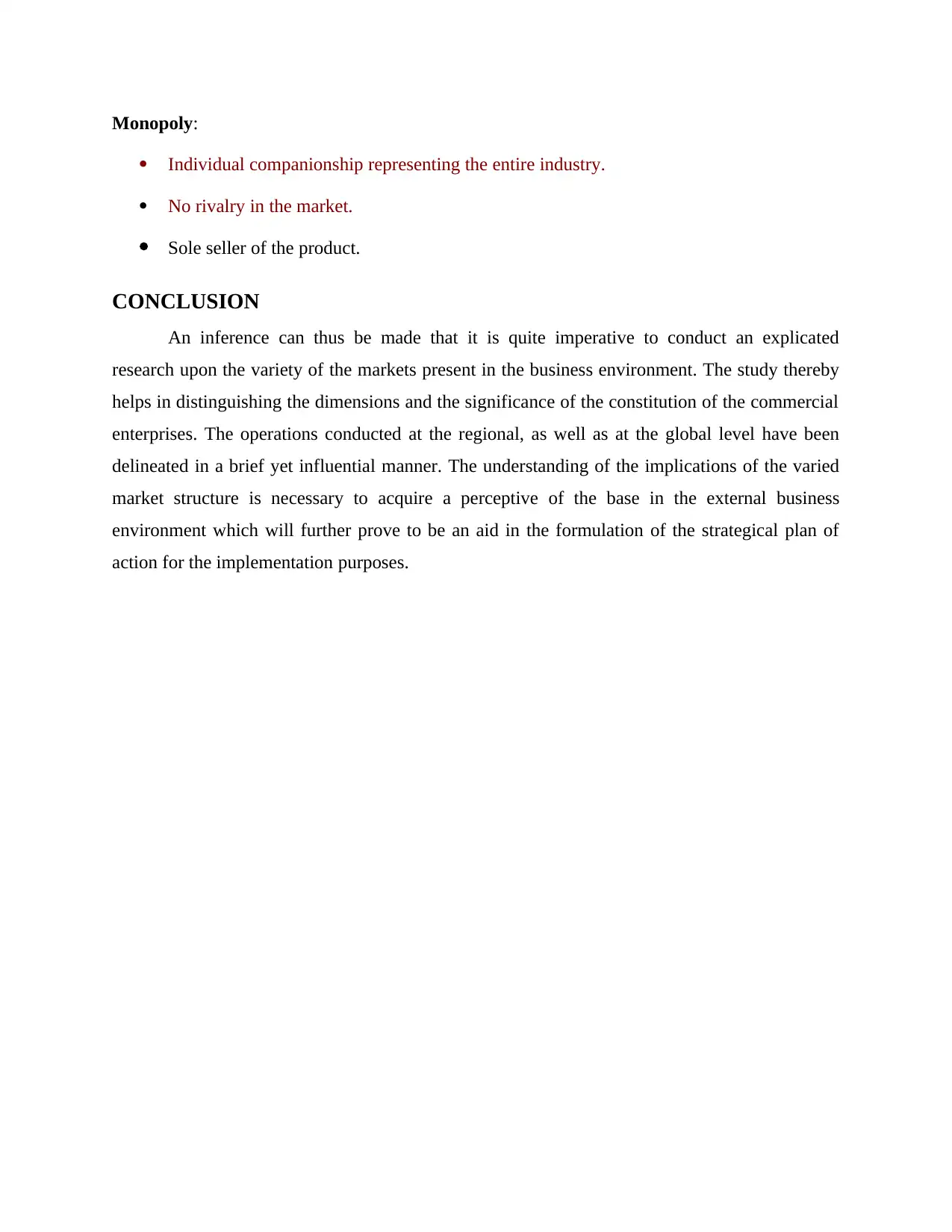
Monopoly:
Individual companionship representing the entire industry.
No rivalry in the market.
Sole seller of the product.
CONCLUSION
An inference can thus be made that it is quite imperative to conduct an explicated
research upon the variety of the markets present in the business environment. The study thereby
helps in distinguishing the dimensions and the significance of the constitution of the commercial
enterprises. The operations conducted at the regional, as well as at the global level have been
delineated in a brief yet influential manner. The understanding of the implications of the varied
market structure is necessary to acquire a perceptive of the base in the external business
environment which will further prove to be an aid in the formulation of the strategical plan of
action for the implementation purposes.
Individual companionship representing the entire industry.
No rivalry in the market.
Sole seller of the product.
CONCLUSION
An inference can thus be made that it is quite imperative to conduct an explicated
research upon the variety of the markets present in the business environment. The study thereby
helps in distinguishing the dimensions and the significance of the constitution of the commercial
enterprises. The operations conducted at the regional, as well as at the global level have been
delineated in a brief yet influential manner. The understanding of the implications of the varied
market structure is necessary to acquire a perceptive of the base in the external business
environment which will further prove to be an aid in the formulation of the strategical plan of
action for the implementation purposes.
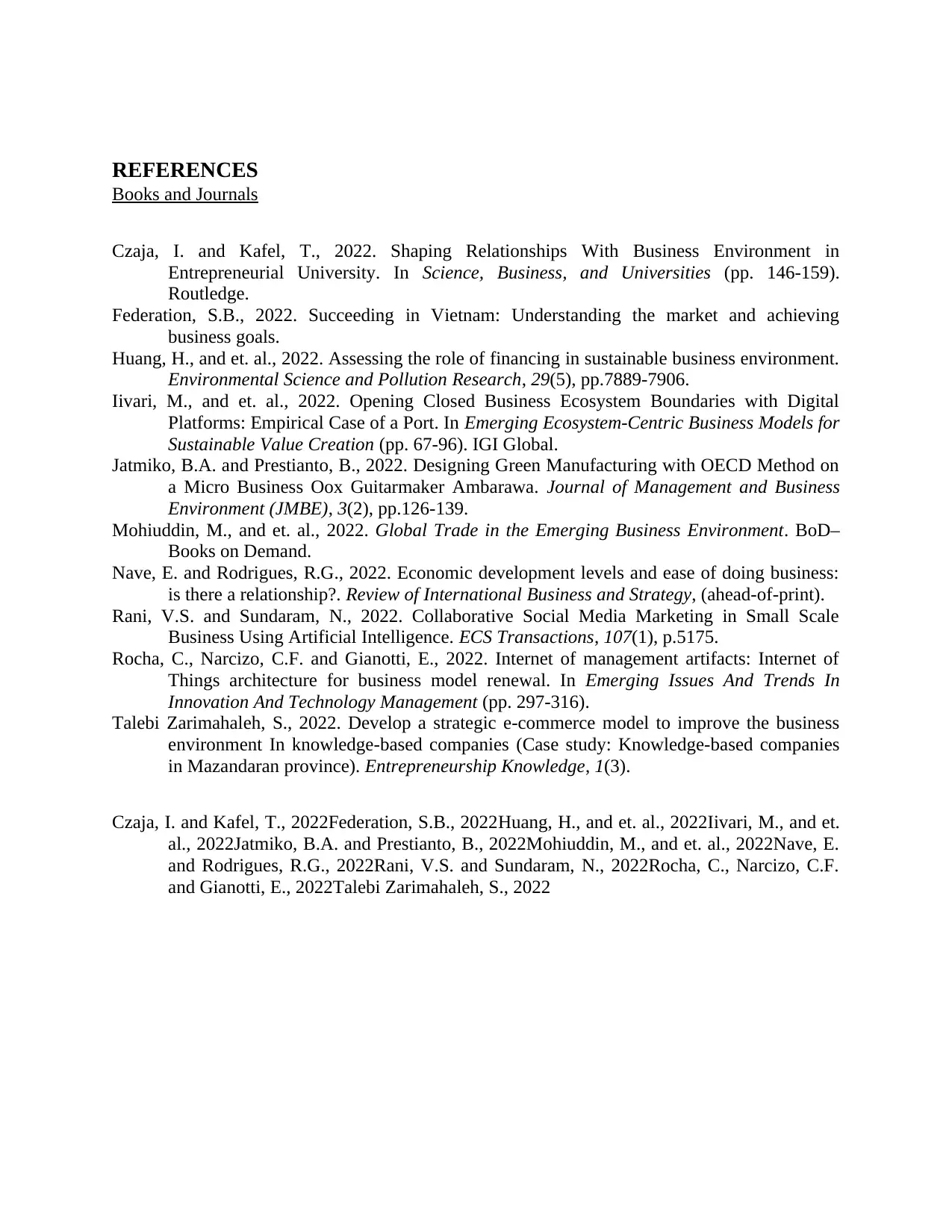
REFERENCES
Books and Journals
Czaja, I. and Kafel, T., 2022. Shaping Relationships With Business Environment in
Entrepreneurial University. In Science, Business, and Universities (pp. 146-159).
Routledge.
Federation, S.B., 2022. Succeeding in Vietnam: Understanding the market and achieving
business goals.
Huang, H., and et. al., 2022. Assessing the role of financing in sustainable business environment.
Environmental Science and Pollution Research, 29(5), pp.7889-7906.
Iivari, M., and et. al., 2022. Opening Closed Business Ecosystem Boundaries with Digital
Platforms: Empirical Case of a Port. In Emerging Ecosystem-Centric Business Models for
Sustainable Value Creation (pp. 67-96). IGI Global.
Jatmiko, B.A. and Prestianto, B., 2022. Designing Green Manufacturing with OECD Method on
a Micro Business Oox Guitarmaker Ambarawa. Journal of Management and Business
Environment (JMBE), 3(2), pp.126-139.
Mohiuddin, M., and et. al., 2022. Global Trade in the Emerging Business Environment. BoD–
Books on Demand.
Nave, E. and Rodrigues, R.G., 2022. Economic development levels and ease of doing business:
is there a relationship?. Review of International Business and Strategy, (ahead-of-print).
Rani, V.S. and Sundaram, N., 2022. Collaborative Social Media Marketing in Small Scale
Business Using Artificial Intelligence. ECS Transactions, 107(1), p.5175.
Rocha, C., Narcizo, C.F. and Gianotti, E., 2022. Internet of management artifacts: Internet of
Things architecture for business model renewal. In Emerging Issues And Trends In
Innovation And Technology Management (pp. 297-316).
Talebi Zarimahaleh, S., 2022. Develop a strategic e-commerce model to improve the business
environment In knowledge-based companies (Case study: Knowledge-based companies
in Mazandaran province). Entrepreneurship Knowledge, 1(3).
Czaja, I. and Kafel, T., 2022Federation, S.B., 2022Huang, H., and et. al., 2022Iivari, M., and et.
al., 2022Jatmiko, B.A. and Prestianto, B., 2022Mohiuddin, M., and et. al., 2022Nave, E.
and Rodrigues, R.G., 2022Rani, V.S. and Sundaram, N., 2022Rocha, C., Narcizo, C.F.
and Gianotti, E., 2022Talebi Zarimahaleh, S., 2022
Books and Journals
Czaja, I. and Kafel, T., 2022. Shaping Relationships With Business Environment in
Entrepreneurial University. In Science, Business, and Universities (pp. 146-159).
Routledge.
Federation, S.B., 2022. Succeeding in Vietnam: Understanding the market and achieving
business goals.
Huang, H., and et. al., 2022. Assessing the role of financing in sustainable business environment.
Environmental Science and Pollution Research, 29(5), pp.7889-7906.
Iivari, M., and et. al., 2022. Opening Closed Business Ecosystem Boundaries with Digital
Platforms: Empirical Case of a Port. In Emerging Ecosystem-Centric Business Models for
Sustainable Value Creation (pp. 67-96). IGI Global.
Jatmiko, B.A. and Prestianto, B., 2022. Designing Green Manufacturing with OECD Method on
a Micro Business Oox Guitarmaker Ambarawa. Journal of Management and Business
Environment (JMBE), 3(2), pp.126-139.
Mohiuddin, M., and et. al., 2022. Global Trade in the Emerging Business Environment. BoD–
Books on Demand.
Nave, E. and Rodrigues, R.G., 2022. Economic development levels and ease of doing business:
is there a relationship?. Review of International Business and Strategy, (ahead-of-print).
Rani, V.S. and Sundaram, N., 2022. Collaborative Social Media Marketing in Small Scale
Business Using Artificial Intelligence. ECS Transactions, 107(1), p.5175.
Rocha, C., Narcizo, C.F. and Gianotti, E., 2022. Internet of management artifacts: Internet of
Things architecture for business model renewal. In Emerging Issues And Trends In
Innovation And Technology Management (pp. 297-316).
Talebi Zarimahaleh, S., 2022. Develop a strategic e-commerce model to improve the business
environment In knowledge-based companies (Case study: Knowledge-based companies
in Mazandaran province). Entrepreneurship Knowledge, 1(3).
Czaja, I. and Kafel, T., 2022Federation, S.B., 2022Huang, H., and et. al., 2022Iivari, M., and et.
al., 2022Jatmiko, B.A. and Prestianto, B., 2022Mohiuddin, M., and et. al., 2022Nave, E.
and Rodrigues, R.G., 2022Rani, V.S. and Sundaram, N., 2022Rocha, C., Narcizo, C.F.
and Gianotti, E., 2022Talebi Zarimahaleh, S., 2022
⊘ This is a preview!⊘
Do you want full access?
Subscribe today to unlock all pages.

Trusted by 1+ million students worldwide
1 out of 9
Related Documents
Your All-in-One AI-Powered Toolkit for Academic Success.
+13062052269
info@desklib.com
Available 24*7 on WhatsApp / Email
![[object Object]](/_next/static/media/star-bottom.7253800d.svg)
Unlock your academic potential
Copyright © 2020–2025 A2Z Services. All Rights Reserved. Developed and managed by ZUCOL.



